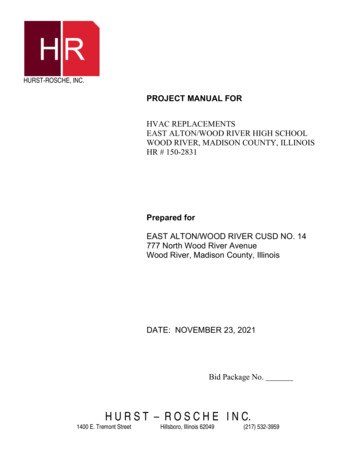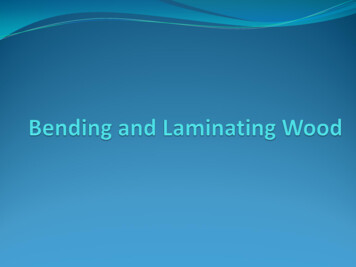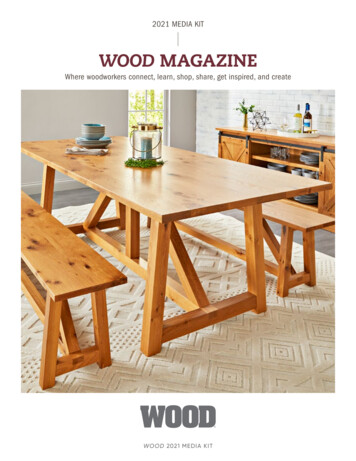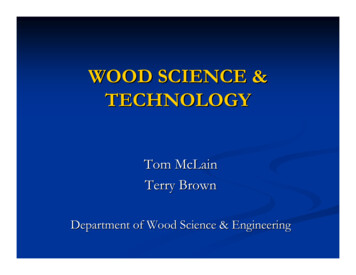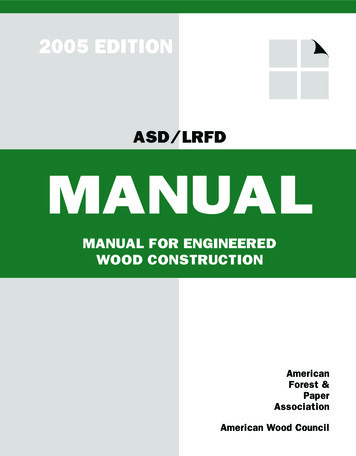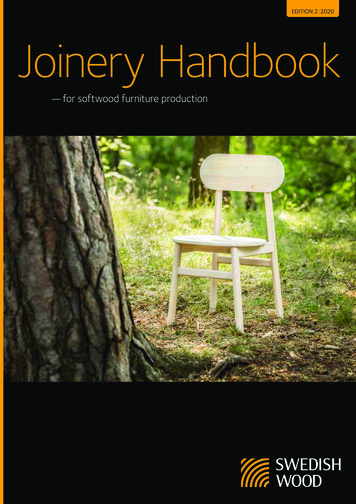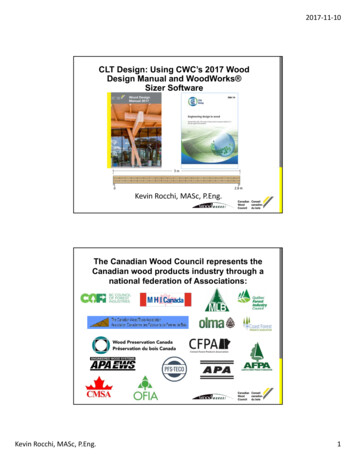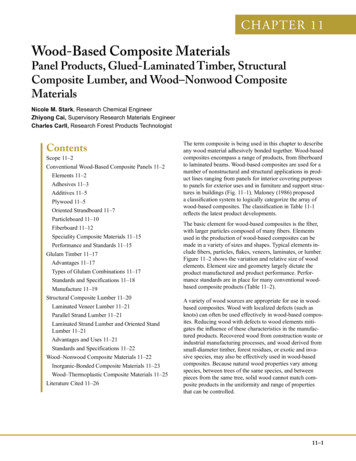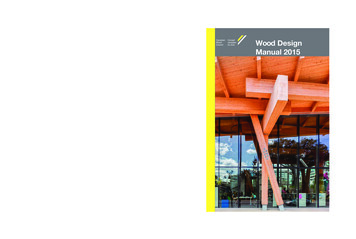
Transcription
tajOMNR çîÉê mêÉëëKéÇÑ N RLOQLNS NWPSWPM mj WoodDesignManual jv jjv v jvh2015ISBN ndu boisWood DesignManual 2015
WoodDesignManual2015
WoodDesignManual2015The completereferencefor wood designin CanadaCanadianWoodCouncilConseilcanadiendu bois
2016 CopyrightCanadian Wood CouncilConseil canadien du boisOttawa, Ontario, Canadawww.cwc.caISBN 978-0-9916862-6-1, 7th revised edition, 2016ISBN 978-0-9783213-6-9, 6th revised edition, 2010(ISBN 0-921628-75-7, 5th revised edition, 2005ISBN 0-921628-62-5. 4th revised edition, 2001ISBN 0-921628-50-1. 3rd revised edition, 1997ISBN 0-921628-33-1. 2nd revised edition, 1995ISBN 0-921628-04-8. 1st edition, 1990)1.5M16-6Book design and production:Accurate, Ottawa, ONPrinting:Gilmore, Ottawa, ONWith the permission of Canadian Standards Association,material is reproduced from CSA Standard CAN/CSA-08614, Engineering Design in Wood, which is copyrightedby Canadian Standards Association, 178 Rexdale Blvd,Toronto, ON, Canada, M9W 1R3. The contents of thismaterial reflect the opinions of the author and do notnecessarily reflect the opinions of the CSA Group.Photo credit front cover and inside front and back covers:Scarborough Civic Centre LibraryBlackwellLGA Architectural Partners and Phillip H. Carter Architects in Joint VenturePhotograph: Ben Rahn/A-FramePrinted in Canada on recycled paper.
Wood Design ManualiPrefaceThe Canadian Wood Council (CWC) is the Canadian association responsiblefor the development and dissemination of technical information on the use ofwood products in construction. Ensuring that this information is in tune withtechnical change and users’ needs is an ongoing process.There has been a surge in the use of wood in both mid-rise residentialand non-residential buildings. Many of these projects push the boundariesof conventional wood building practices and highlight the special qualities,versatility and sheer beauty of wood as a building material. The potential forwood use in Canada is expanding. Wood is now being introduced in tallerbuilding construction and the use of proprietary engineered wood products and cross-laminated-timber make wood a viable alternative in manyapplications.The purpose of this seventh edition of the Wood Design Manual is to helpthe Canadian design community – architects, engineers, specification writers, teachers and students of these disciplines – to design wood structureswith efficiency, economy and safety. It brings together, in a comprehensive butconcise format, the essential information a designer needs for a wide range ofwood structural elements and systems.The CWC would like to thank the individuals who were instrumental inthe original development of this manual: Stephen J. Boyd, Quaile EngineeringLtd., and Gary C. Williams, Timber Systems Ltd.Michael GirouxPresidentMay 2016The information in the Wood Design Manual is based on the latestinformation available from the National Building Code of Canada(2015) and from CSA Standard O86-14 Engineering Design inWood. Every effort has been made to ensure that the data andinformation in the Manual are accurate and complete. The CWCdoes not, however, assume any responsibility for errors or omissions in the Manual nor for engineering designs or plans preparedfrom it.Errata available at:www.cwc.ca/publications/erratas/*For information on CWC’s other design tools, visit the CWC web site at www.cwc.ca
ii
Wood Design ManualiiiSustainable Building Materials –Wood is the Natural ChoiceSustainable Buildings and Green Buildings are gaining interest of designerslooking to conserve energy and minimize the environmental impact of buildings using four generally accepted objectives to reduce the global impact ofa particular product or system: Reduced energy and resource use in extraction and processingReduced energy consumption in processing and end useMinimized external pollution and environmental damage throughoutthe life cycleMinimized internal pollution in the built environment.Wood is the best environmental choice to meet these four principlesbased on the following: Wood is the only renewable major construction materialWood is energy efficient in manufacture and useWood is easily recycled or re-usedWood minimizes environmental impactCanadian wood products are produced from well managed forests that areregulated by sustainable forestry policy.Life-Cycle AssessmentLife Cycle Assessment is a performance-based approach to assessing theimpacts that building products or systems have on the environment overtheir lifetime. This includes all activities from material extraction or harvestingthrough manufacturing, transportation, installation, use, maintenance, andfinal disposal or re-use. LCA is the best available tool to compare sustainabilityof building materials.When considering environmental impact using Life Cycle Assessment,wood outperforms other major building materials in the following ways: Requires less embodied energy in production Reduces greenhouse gas emissions Releases fewer pollutants into the air Discharges less water pollutants Generates fewer solid wastes.
ivEnvironmental Benefits of Building with WoodSustainable Forest ManagementCanada is a world leader in forest conservation, protection and sustainableuse. 93% of Canada’s forests are on crown land and provincial governmentsenforce strict guidelines on harvesting, regenerating and sustaining thesepublicly owned forests.For example: Canada has the largest area of legally protected forests in the worldCanada has the largest area of original forest cover in the world (90%)Only one-quarter of Canada’s forests are managed for commercial useAnnually, Canada harvests less than one-half of 1% of its forestCanada has the largest area of independently certified forests inthe worldCanada’s history of caring for our resource base and our desire to continuallyimprove has made these facts a reality. Canadian law, as it now stands, has someof the most progressive legislation for forest managementin the world.Public concerns focus on the highly visible effects of wood resourceextraction. To address these concerns, Canadian wood product manufacturers are using certification by qualified, 3rd party, independent bodies to attestthat they meet the requirements of a rigorous and independent forest management standard. Canadian companies have achieved third-party certificationon over 140 million hectares (250 million acres) of forests, the largest area ofcertified forests in the world.
vWood Design ManualTable of ContentsIntroduction1.11.2General Information . . . . . . . . . . . . . . . . . . 3Limit States Design . . . . . . . . . . . . . . . . . . 5BendingMembers2.12.22.32.42.52.62.72.8General Information . . . . . . . . . . . . . . . . . 15Sheathing & Decking . . . . . . . . . . . . . . . . 17Lumber Joists . . . . . . . . . . . . . . . . . . . . . 31Engineered Joists . . . . . . . . . . . . . . . . . . 45Beams and Purlins . . . . . . . . . . . . . . . . . 49Built-up Beams . . . . . . . . . . . . . . . . . . . . 75Two-way Bending Members . . . . . . . . . . 77Cantilevered Beams . . . . . . . . . . . . . . . . 85CompressionMembers3.13.23.33.4General Information . . . . . . . . . . . . . . . . . 97Stud Walls and Posts . . . . . . . . . . . . . . . 99Columns . . . . . . . . . . . . . . . . . . . . . . . . 113Built-up Columns . . . . . . . . . . . . . . . . . 143TensionMembers4.14.2General Information . . . . . . . . . . . . . . . . 155Lumber and Glulam . . . . . . . . . . . . . . . . 157CombinedLoads5.15.2General Information . . . . . . . . . . . . . . . . 177Stud Walls . . . . . . . . . . . . . . . . . . . . . . . 19312345
viBearing6.16.26.3General Information . . . . . . . . . . . . . . . . 213Bearing Resistance of Wood . . . . . . . . . 215Bearing Plates . . . . . . . . . . . . . . . . . . . . .12General Information . . . . . . . . . . . . . . . . 233Nails and Spikes . . . . . . . . . . . . . . . . . . 239Wood Screws . . . . . . . . . . . . . . . . . . . . 253Bolts and Dowels . . . . . . . . . . . . . . . . . 267Drift Pins . . . . . . . . . . . . . . . . . . . . . . . . 333Lag Screws . . . . . . . . . . . . . . . . . . . . . . 337Timber Rivets . . . . . . . . . . . . . . . . . . . . 349Shear Plates and Split Rings . . . . . . . . . 369Truss Plates . . . . . . . . . . . . . . . . . . . . . . 389Joist Hangers . . . . . . . . . . . . . . . . . . . . 397Framing Anchors . . . . . . . . . . . . . . . . . . 399Typical Connection Details . . . . . . . . . . 403ShearwallsandDiaphragms8.18.28.38.4General Information . . . . . . . . . . . . . . . . 435Diaphragm Design . . . . . . . . . . . . . . . . . 439Shearwall Design . . . . . . . . . . . . . . . . . . 465Seismic Design Considerations forShearwalls and Diaphragms . . . . . . . . . 507Applications9.19.29.39.49.5Design forFire SafetyGeneral Information . . . . . . . . . . . . . . . . 529Curved Glulam . . . . . . . . . . . . . . . . . . . . 531Timber Arches . . . . . . . . . . . . . . . . . . . . 537Pitched-tapered Beams . . . . . . . . . . . . 547Pyramidal, Domedand A-frame Buildings . . . . . . . . . . . . . . 5619.6 Heavy Timber Trusses . . . . . . . . . . . . . . 5659.7 Light Frame Trusses . . . . . . . . . . . . . . . 5719.8 Permanent Wood Foundations . . . . . . . 5799.9 Stressed-skin Panels . . . . . . . . . . . . . . . 5899.10 Cross Laminated Timber . . . . . . . . . . . . 5939.11 Concrete Formwork . . . . . . . . . . . . . . . . 59510.110.210.310.410.510.610.7General Information . . . . . . . . . . . . . . . . 611Definitions . . . . . . . . . . . . . . . . . . . . . . . 613Wood Construction . . . . . . . . . . . . . . . . 615Fire-resistance Ratings . . . . . . . . . . . . . 621Determining Fire-resistance Ratings . . . 623Flame-spread Ratings . . . . . . . . . . . . . . 639Fire-retardant-treated Wood . . . . . . . . . 641678910
viiWood Design ManualReferenceInformation11.1 General Information . . . . . . . . . . . . . . . . 64711REFCommentaryCSA O86EngineeringDesign in WoodVisit our website athttp://cwc.ca/publications/wdm2015/ to access thelatest version of the Commentary.CSAO86COMCSA O86Reprint of CSA O86 . . . . . . . . . . . . . . . gray pagesAppendixList of Symbols . . . . . . . . . . . . . . . . . . . . . . . . . A-3Index . . . . . . . . . . . . . . . . . . . . . . . . . . . . . . . A-7
viii
ucts and cross-laminated-timber make wood a viable alternative in many applications. The purpose of this seventh edition of the Wood Design Manual is to help the Canadian design community – architects, engineers, specification writ-ers, teachers and students of these disciplines – to design
